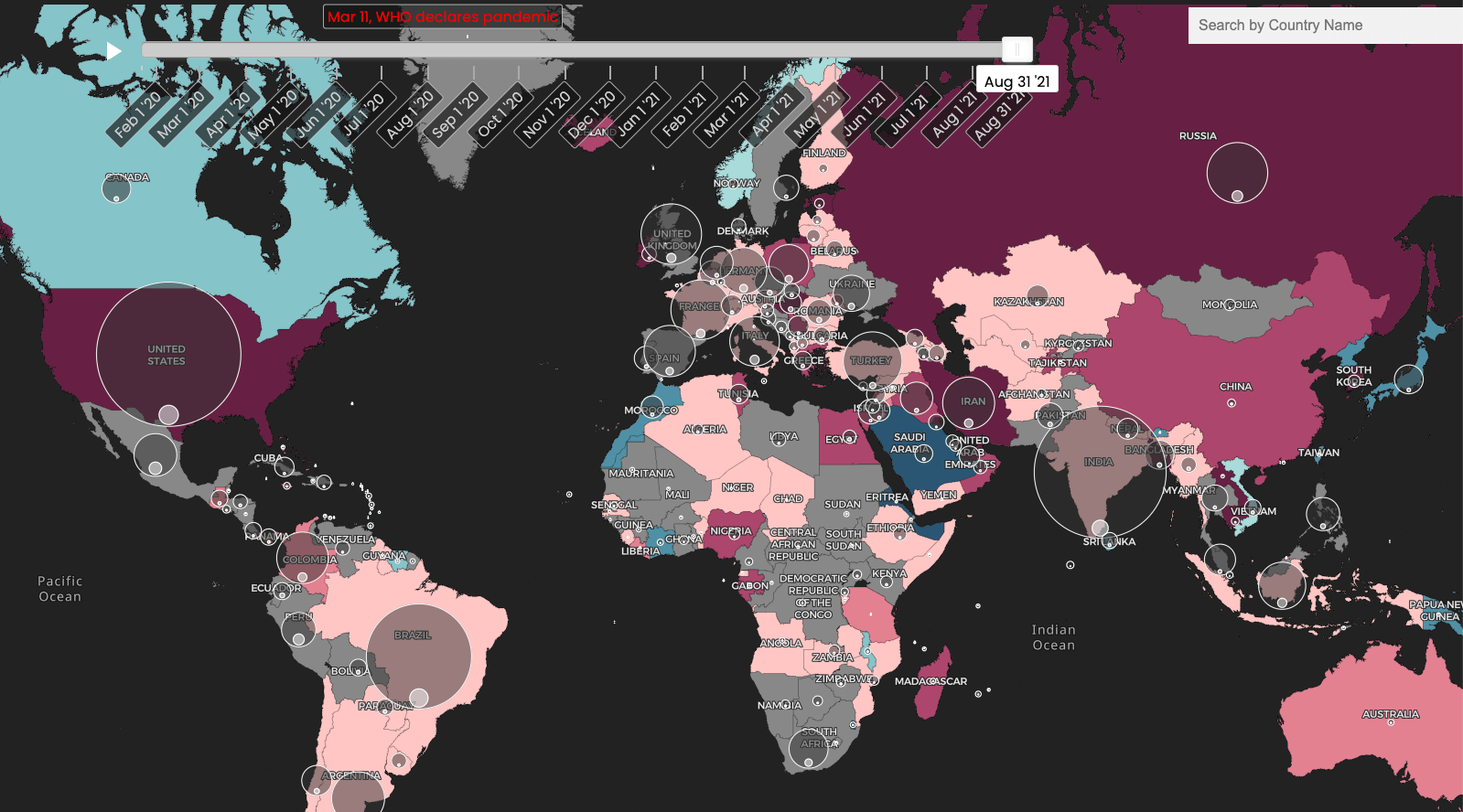In response to the onset of the COVID-19 pandemic in March 2020, Europe saw most of its borders close internally and all its borders shut to the rest of the world. Numerous data collection projects emerged to capture country responses to the pandemic, but few focused on borders and immigration policies. To allow researchers to examine the impacts of these closures, I launched the COVID Border Accountability Project (COBAP) to document the timelines of international border closures introduced in 2020-21.
COBAP curated a database of when each country introduced a border closure in response to COVID-19, whether the border closure was complete or partial, and, if partial, which points of access and/or countries’ populations were impacted by the closure. Launched initially as a blog post in Stanford University’s Immigration Policy Lab (IPL), the results of this mapping project were recently published in the Nature Portfolio’s Scientific Data. Havard Dataverse hosts our open data for researchers, and our project website (covidborderaccountability.org) visualizes the data interactively for non-academic users. Here I focus on countries in the Schengen area, a cross-national agreement within the European Union (EU) that abolishes border checks between its member-states. The pandemic border closures and controls countered Schengen’s core principle of freedom of movement. Yet, they also resulted in unprecedented levels of institutional cooperation related to travel across Europe, with policy impacts that remain unknown.
There are 26 member-states of Schengen, most of which are also part of the EU. Prior to the current pandemic, both citizens of the member-states and foreigners who entered the Schengen Area could travel freely within it, without passing through border controls. Throughout the 2020-21 pandemic, however, 25 out of 26 Schengen countries introduced internal border closures. Incoming travel to the EU was severely limited. This article (1) serves as a comparison point for how the Schengen institution and Schengen countries responded to the pandemic in the context of the rest of the world and (2) foregrounds the need for further research on whether Schengen’s border closures were necessary for reducing the spread of SARS-CoV-2.
Compared to the rest of the world, Schengen’s response to COVID-19 was unique. Their “Re-open EU” platform of border closures and controls, launched in July 2020, was updated over time according to reported case counts, whereas most countries announced closures and reopenings on more of an ad hoc basis. Re-open EU utilized a “traffic light” system with recommended measures for travelers from specific countries organized into “red,” “green,” and “yellow” lists. These lists corresponded with reported spread per 100,000 people in the last 14 days of the sending country. Travelers from countries on the green list could enter with no additional restrictions. There were additional measures in place for arrivals from yellow list countries, such as proof of a negative test result. Those arriving from red list countries had the most severe restrictions, including being barred from entry altogether.
The pandemic border closures and controls countered Schengen’s core principle of freedom of movement. Yet, they also resulted in unprecedented levels of institutional cooperation related to travel across Europe, with policy impacts that remain unknown.
Most countries outside the EU that are typically sites of significant international travel, such as the United States (U.S.), did not introduce national-level responses to the pandemic related to movement across their borders. Instead, the U.S. introduced a series of targeted bans throughout 2020. First, it announced a ban on travelers from Wuhan, China on January 31, 2020. Next, then-U.S. President Trump issued a ban on travelers from Iran on February 29, citing both Iran’s outbreak of SARS-CoV-2 and the country’s “history of malign activity.” Then, it barred entry to travelers on March 13 from the entire Schengen Area, citing “the free flow of people between the Schengen Area countries.” The U.S. did not set criteria for when these bans would end but rather stated they would be in place “until terminated by the President.”
Russia implemented a series of targeted bans that were remarkably similar in terms of timeline and countries targeted to those introduced by the U.S. First, Russia barred visa applicants from China (January 31, 2020), Iran (February 28), and then throughout March, introduced a series of restrictions on travel to/from Europe. The notable difference between the two country’s initial approaches was that, unlike Russia, U.S. restrictions on travel from China made an exception for travel to/from Hong Kong. Turkey, similarly to the U.S. and Russia, introduced a series of border policies targeting travelers from Iran, China, and several European countries. The extent to which these countries cooperated or imitated each other’s early targeted bans is unclear.

South Africa introduced a travel ban barring foreign nationals from “high risk” countries, suspending existing and future visas for people from Italy, Iran, South Korea, Spain, Germany, the U.S., the United Kingdom (UK) and China (March 15, 2020). Brazil closed all of its land borders on March 18 (except with Uruguay) and introduced additional screening measures at airports for travelers from a large set of countries. Australia initially implemented targeted bans, then completely closed their borders to both incoming and outgoing travel on March 20, instituting one of the most restrictive movement-related responses to the pandemic. China suspended entry to most foreign travel on March 28. The UK, then still part of the EU, introduced no border closures initially, instead relying on a national lockdown, recommendations against incoming travel, additional airport screening measures, and mandated quarantines upon entering the country.
What makes Schengen’s response to the pandemic uniquely crucial to study in both the biomedical and social sciences is that introducing border closures broke with its core principle of freedom from border controls, but at the same time provided one of the most comprehensive and consistent responses to COVID-19 in the world. With clear criteria for how it would adjust and reverse border restrictions, Schengen’s response provided affected populations with consistent, objective recommendations. Answering the question of whether or not Schengen member-states consistently implemented these recommendations requires an examination of case studies. For instance, several Schengen countries pursued a dual strategy of following the Re-open EU recommendations for closures and introducing additional closures. An exception to the EU’s case-based travel advice was the recommendation that countries open their borders to travel from the U.S. in anticipation of the summer tourist season. This recommendation came in spite of the consistently high count of SARS-CoV-2 cases in the U.S. throughout 2021, amplified by the delta variant. Most Schengen countries followed this advice and tourist travel from the U.S. commenced.
It is my hope that our careful mapping of the European context allows current and future analyses to address whether border closures make sense in a pandemic and if so, for how long, which kind, and when.
Studies on whether the EU’s border closures reduced transmission of the virus (and whether exceptions made for tourist travel reversed those gains) remain limited by data availability problems. However, this research is critical and possible because Europe’s testing capacity was relatively high. As such, studies are uniquely viable for parsing the efficacy of their health impacts around critical policy introductions, as well as for weighing the socioeconomic impacts of the bans. For this reason, the COBAP database includes both EU/Schengen travel recommendations and individual member-state border closures. (For our full list of EU-related terms and database inclusions, see our open source project guidelines.) It is my hope that our careful mapping of the European context allows current and future analyses to address whether border closures make sense in a pandemic and if so, for how long, which kind, and when.
In sum, Europe’s response to the pandemic both threatened its internal Schengen agreement and, at the same time, was uniquely consistent on border closures when compared to the rest of the world. Addressing the question of whether the public health gains of closures were worth putting the brakes on Schengen is a pressing and yet unanswered question.
Further recommended reading on the subject
- Sergio Carrera and Ngo Chun, "In the Name of COVID-19: An Assessment of the Schengen Internal Border Controls and Travel Restrictions in the EU," European Parliament’s Policy Department for Citizens’ Rights and Constitutional Affairs, September 2020.
- Sofian Philip Nacuer, "COVID-19 Is Grist to the Border Regime Mill," Rosa Luxemburg Foundation, July 2020. Available here.
- Mary A. Shiraef, "Closed borders, travel bans and halted immigration: 5 ways COVID-19 changed how – and where – people move around the world,"The Conversation, March 2021.
- Mary A. Shiraef et. al. "The COVID Border Accountability Project, a hand-coded global database of border closures introduced during 2020," Scientific Data, Nature Portfolio, September 2021.
About the author

Mary A. Shiraef (@Mary-Shiraef) is a Ph.D. Candidate in political science at the University of Notre Dame, founder of the @COBAPTeam, and recent Nanovic grant recipient. Her work examines processes of migration and identity politicization, with a focus on how collective memory takes shape in authoritarian regimes. Her dissertation project centers at the border between the EU member-state candidate Albania and EU member-state Greece.
Lukas Feddern (@lukas_feddern), Yashwini Selveraj (@YeshwiniSRaj), Paul Friesen (@Paul_Freezy) and the COBAP Team (@COBAPteam) contributed research to this article. Sources for policies referenced are archived in the COBAP Team database. The sources are accessed easily by clicking on a country through our project website.
Originally published by at eitw.nd.edu on December 16, 2021. Europe in the World provides accessible analyses and commentary on Europe’s political, social, and economic relations with the rest of the globe. It is a platform for scholars of Europe to present their ideas in a form that helps bridge the gap between the academy and the general public.